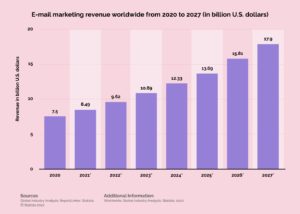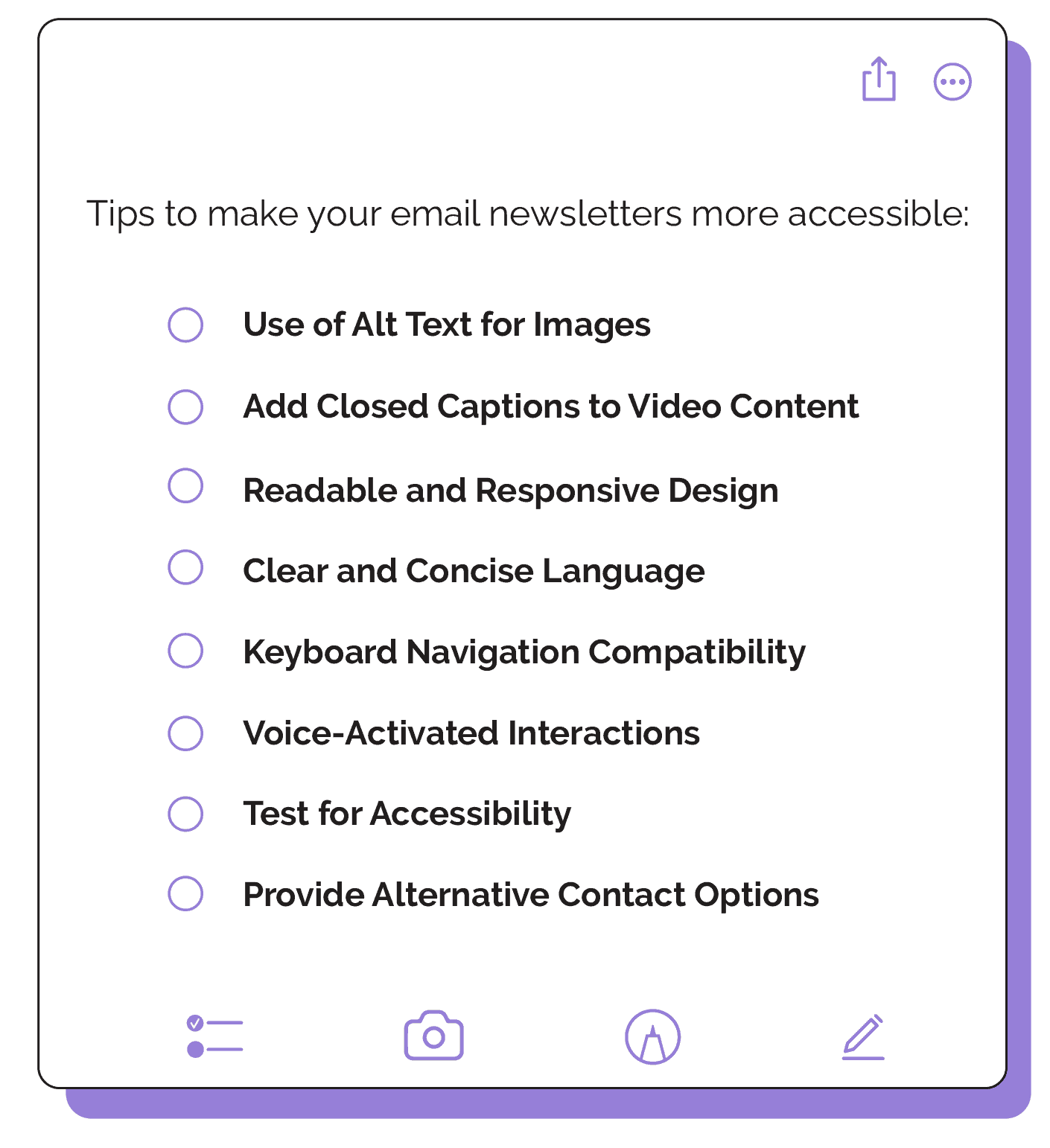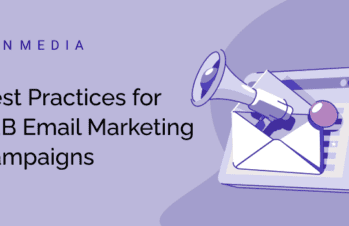Email is still one of the most effective ways to communicate with your customers, and this isn’t going to change in 2024. There are 4 billion daily email users—expected to grow to 4.6 billion by 2025—and a survey of active email users showed that 59% of consumers’ purchase decisions were influenced by marketing emails. Additionally, more than half reported purchasing from marketing emails at least once a month.

For B2B marketers, email is a critical way to build relationships with clients and prospects. And with many businesses operating in remote or hybrid environments, email is even more important. If your business operates strictly online, you must be cautious that social media platforms can disappear or change their algorithms at any time, potentially severing your connection with your audience. Unlike social media platforms, email is an owned channel that provides a reliable way to reach and engage your audience, even when other platforms go down or lose popularity.
B2B email marketing trends in 2024 will continue along the same path as previous years, with industry revenue estimated to reach almost $17.5 billion by the end of 2027. Emails will continue to become more automated, include more videos, be more personalized, and more interactive.

Source: https://www.emailmonday.com/email-marketing-future
B2B Email Marketing Trends in 2024
1. Leverage AI for Hyper-Personalization
Mass, impersonal email blasts just don’t work. Emails that use people’s first names get higher open rates than those that simply say “Dear Customer.” Personalizing the “from” field of your email is also a good idea. Ensuring clarity about the sender boosts engagement; emails sent from personalized accounts have higher open rates compared to those sent from a “no reply” address.
But that’s just the basics. Personalization shouldn’t stop at first names and sign-offs. Every aspect of the emails you send should feel customized for the recipient.
With advancements in artificial intelligence, email marketing personalization can go beyond using the recipient’s first name. AI can help tailor content, product recommendations, and send times to individual preferences based on interaction history. One of the most significant trends is the integration of AI tools for dynamic content creation and predictive analytics, both of which enhance personalization.
Create thoughtful and personalized email subject lines that are relevant to your subscribers. It’s important that the subject line gives your readers an idea of what your email will be about. Avoid using something catchy that simply tries to trick people into opening your emails. Nobody likes to be tricked.
Also, make sure your mailing list is segmented. This allows you to craft copy that meets the specific needs of each segment, rather than using impersonal, general copy.
2. Embrace Advanced Segmentation Techniques
Another B2B email marketing trend that continues to gain traction is the use of microsegmentation. Microsegmentation involves dividing your audience into smaller, more specialized groups based on specific characteristics or behaviors, allowing you to create highly targeted email campaigns.
By breaking down the audience into smaller segments based on detailed criteria—such as job roles, industry types, company sizes, or even engagement levels with previous campaigns—marketers can craft messages that are significantly more relevant to each group. This relevance boosts the likelihood of engagement, as recipients perceive the content to be specifically tailored to their needs and challenges.
Taking microsegmentation a step further, behavior-based targeting is a highly effective email marketing strategy. This approach involves meticulous analysis of individual recipient actions and interactions across various touchpoints, such as website visits, content downloads, email opens, and click-throughs. By understanding these behaviors, marketers can deduce the recipient’s stage in the buying journey, interests, and potential pain points, enabling the delivery of content that is not just timely but also aligned with the recipient’s current needs and preferences.
For instance, a recipient who frequently downloads whitepapers on a particular topic might be interested in a deep dive webinar on the same subject. Similarly, someone who consistently opens emails but doesn’t click through might need a different approach, perhaps more compelling calls to action or a different type of content altogether.
To effectively implement these advanced segmentation techniques, it’s essential to leverage the capabilities of sophisticated CRM and marketing automation tools. These tools can automate the data analysis process, identify patterns in customer behavior, and even predict future actions based on historical data. With this technology, creating dynamic segments that update in real-time based on user behavior becomes feasible, ensuring that your marketing efforts are always as relevant and personalized as possible.
A/B testing plays a crucial role in refining your segmentation strategy. By testing different messages, subject lines, and content formats across various segments, you can gather valuable insights into what resonates best with each group, further tailoring your approach to meet their preferences.
This customized approach not only increases open and click-through rates but also fosters a deeper connection with the audience. By demonstrating an understanding of their specific needs and behaviors, companies can build trust and credibility, paving the way for stronger customer relationships and, ultimately, driving higher conversion rates.
3. Focus on Interactive Customer Experiences
In 2024, interactivity in B2B email marketing is set to become even more important as businesses continue to find ways to engage their audience and drive conversions.
One of the key trends to watch out for is the integration of new technologies like AMP for Email, which will allow recipients to take actions such as filling out forms or browsing products directly within their email. AMP for Email, or Accelerated Mobile Pages for Email, allows for dynamic and interactive content within emails, making them more engaging and personalized for recipients.
You can increase engagement by including GIFs, quizzes, countdown timers, and add-to-cart functionality in your emails. Another way to increase interactivity and engagement is to send to lists that actually want to hear from you. Stop sending to email lists with low open rates. Low open and engagement rates hurt your domain reputation and your chances of engaging with other customers who are interested in hearing from you. Don’t be afraid to remove subscribers who aren’t opening your emails.
Also, make sure you have a goal for your email before you hit send. Think about what you want your subscribers to do, if anything, before drafting your email. Identify the purpose of your email, then write the entire email with that in mind. Make it easy for your subscribers to do what you want them to do. If you want them to read your blog post, then provide a link to the post. Provide more than one way for your subscribers to achieve your goal by using links in the text of your email and buttons or calls to action at the end of your email.

Gamification in email marketing involves incorporating game design elements into emails to create a more engaging and interactive experience for recipients. This could include challenges, quizzes, puzzles, or interactive stories that encourage participation and engagement. By turning email interactions into a more dynamic and fun experience, businesses can significantly increase open rates, click-through rates, and overall engagement. Gamification also offers unique opportunities for personalization and segmentation; for example, sending different game challenges based on the recipient’s previous interactions or preferences. This strategy not only makes email content more engaging but also encourages recipients to look forward to receiving and interacting with your emails. Additionally, incorporating rewards for participation, such as discounts, exclusive content, or customer loyalty points, can further incentivize engagement and foster a stronger connection between the brand and its audience.
4. Emphasize Data Privacy and Security
Use the built-in analytics that comes with your email management system to improve your open rates. Think of the analytics as feedback and make note of how the numbers move (up or down) when you change something. This often requires a lot of testing.
Play around with the day you send your emails and see what works best for your subscribers. Tuesdays, Wednesdays, and Thursdays are the most popular days to send emails, so an email sent on one of those days is not as likely to be opened because your subscribers will be inundated with emails from other lists they’ve joined.
Respecting your subscribers’ privacy is also paramount this year. With the trend towards our cookieless future, brands need to be mindful of how much information they collect from their subscribers, how they store that information, as well as the updated laws and regulations regarding digital consumer privacy.
With the increasing number of regulations such as GDPR and CCPA (the General Data Protection Regulation and California Consumer Privacy Act, respectively), as well as heightened consumer awareness about how their data is being used, businesses must prioritize safeguarding their customers’ information.
One of the key trends that we’ll see in B2B email marketing is the increased adoption of secure sending practices. With the rise of cyber threats and data breaches, businesses are becoming more vigilant about protecting their sensitive information when it comes to email communication.
One of the main ways that companies can ensure secure sending practices is by implementing end-to-end encryption for their emails. This encryption method ensures that only the intended recipient can access the contents of the email, providing an extra layer of protection against unauthorized access.
In addition to encryption, businesses will also need to focus on obtaining explicit consent from their customers before sending them marketing emails—easily done through an opt-in form. Regulations such as GDPR and CCPA require companies to obtain consent from individuals before processing their personal data, including sending marketing communications.
Make sure you are focusing your data analysis on subscribers who have submitted a form on your website. Don’t buy email lists—or, if you do, make sure to cull that list based on recipient behaviors. If unsubscribing seems to be a trend, then you’ll want to find out what’s going on. This is also true if people aren’t opening your emails. Respect your subscribers’ wishes. If you are sent to the spam folder and marked as spam, then immediately stop sending emails and see if you can find out what may have caused your subscribers to consider your emails spammy.
The definition of spam has evolved. It’s no longer just emails sent without explicit permission—it now includes emails sent to subscribers who consistently ignore them, known as graymail. In this case, unsubscribes can be beneficial, as they decrease your risk of sending graymail and enhance the likelihood that your emails are being read by engaged subscribers.
5. Use AI for Enhanced Analytics and Automation
As technology continues to evolve, so do the tools available for tracking, analyzing, and automating email marketing efforts.
One key development in this area is the rise of AI-driven predictive analytics. These sophisticated algorithms are able to analyze data and predict future outcomes, helping businesses make informed decisions about their email marketing practices.
AI-driven predictive analytics is revolutionizing the way B2B marketers approach email campaigns. By using machine learning algorithms to sift through vast amounts of customer data, businesses can now better understand their audience’s behavior and preferences. This allows them to tailor their email content and timing for maximum engagement and conversions.
Small businesses, in particular, will need to take advantage of AI automation if they want to stay competitive. The key behind automation is that it’s designed to save businesses time and money. It’s also linked to consumer behavior, such as filling out a form or adding something to their cart on your website. This means that an automated email is 70.5% more likely to be opened. It provides information to your potential customers exactly when they need it.
6. Stay Updated on Email Design Trends
In 2024, B2B email marketing design trends will continue to evolve, with a focus on creating visually appealing and engaging designs that capture the attention of busy professionals.
The shift towards minimalist design in email marketing is driven by the recognition that simplicity can enhance message clarity and engagement. This design philosophy focuses on core content and actions, stripping away any superfluous elements that might distract or detract from the message. The use of white space, clear typography, and a limited color palette helps to draw attention to the most important parts of the email, like key messages and calls to action (CTAs).
Minimalist designs not only make emails visually appealing but also improve readability and user experience. By keeping the design clean and simple, businesses can ensure that their message is easily understood by recipients without any distractions.

This seems like a no-brainer in 2024. I mean, everyone is on mobile, right? But still, many brands lag in creating emails that can be easily read on a mobile device. Things like subject-line character counts and how images display can make or break a consumer’s interaction with your brand. When thinking about mobile viewing, keep your subject lines short, your content concise, and use clear CTAs and engaging preheader text.
7. Integrate with Sales and Marketing Automation Platforms
By integrating email marketing with CRM (Customer Relationship Management) and marketing automation platforms, businesses can ensure a seamless transition for customers as they move through the sales funnel. This integration allows for the automatic sharing of customer data and interactions across platforms, enabling a unified view of the customer. Marketers can leverage this information to create highly targeted and personalized email marketing campaigns that resonate with the recipient’s current stage in the customer journey, significantly boosting conversion rates and customer retention.
The integration facilitates streamlined workflows, reducing manual tasks and the potential for human error. For instance, when a prospect fills out a form on your website, their information can automatically populate in both your CRM system and email marketing platform. This automation saves time and ensures that follow-up emails are timely and relevant, increasing the likelihood of engagement. Sales teams can also benefit from these integrations by receiving instant notifications about customer actions, such as email opens or clicks, enabling them to act promptly and effectively.
8. Create Value-Driven, Narrative Content
As always, content is king. (Well, we may be a little biased, but the stats don’t lie.) Creating high-quality, valuable content that adds value for your reader reduces the amount of graymail you send and increases the likelihood of creating an authentic connection with your target audience—someone who will actually convert.
The core of your email marketing should be content that adds tangible value to your recipients’ lives. This means going beyond promotional messages to deliver content that educates, informs, and solves problems.
Think about your ideal customer and what they want to know. Do they want tips and tricks, personal stories, or the latest deals? Maybe they want all of those things. Knowing and understanding your customers is key. A good rule of thumb is to send emails that provide value to your customers 80% of the time and promotional emails the other 20%.
By focusing on value-driven content, you position your brand as a helpful resource, building trust and loyalty among your audience. This could include how-to guides, industry insights, tips and tricks, or interactive elements like quizzes and surveys that engage recipients in a meaningful way. The goal is to empower your subscribers with knowledge or solutions that they appreciate and look forward to receiving in their inbox.
Alongside educational content, weaving storytelling into your email campaigns can dramatically enhance their impact. Stories have the power to humanize your brand, making it more relatable and memorable to your audience. Incorporate customer success stories to showcase the real-world value of your products or services. Share behind-the-scenes glimpses of your company to build a sense of community and transparency. Celebrate company milestones and share your journey, inviting your subscribers to be a part of your brand’s story. These narratives not only create an emotional connection but also illustrate your brand’s values and mission in action.
The most compelling email content strikes a balance between being informative and engaging. By integrating value-driven content with storytelling, you create a rich, multifaceted email experience that captivates your audience. For instance, a customer success story can be more than just a testimonial; it can include actionable insights or lessons that other potential customers can apply. Similarly, behind-the-scenes content can be educational, showing subscribers how your products are made or how your team tackles challenges.

Video requires little effort to understand and is quickly and easily consumed, especially on mobile devices. Until recently, many email management systems (EMS) were unable to display embedded video, but this is quickly changing. If your EMS doesn’t allow embedded video, watch for this to change very soon. In the meantime, animated GIFs can be used in place of video, or you can even use an image with a play button as a way to link to a site where your customers can play your video. Nowadays, it’s pretty cost-effective to hire a freelance animator to create a short set of branded animated gifs for your business, which will inevitably provide a solid ROI.
9. Leverage User-Generated Content
We’ve talked a lot about user-generated content (UGC) on the Zen blog throughout the last few years. It’s hugely popular because people want the opinions of their trusted peers. In fact, 93% of consumers turn to customer reviews and recommendations before making their purchase decisions.
Incorporating UGC in your brand’s email campaigns will heighten the authentic connection recipients will feel towards your brand. Your audience trusts their peers—customer reviews, photos, and video testimonials will carry more weight than cookie-cutter marketing messages.

To elevate the impact of UGC, adopting a more strategic approach is essential. Rather than merely including user reviews or testimonials, consider curating diverse forms of UGC that reflect the broad spectrum of your customer base. Featuring customer stories, reviews, and user-generated videos can create a repository of real-world experiences that foster a sense of community and authenticity around your brand. This enhanced approach to UGC not only captivates your audience’s attention but also encourages further engagement and content creation, creating a virtuous cycle of trust and authenticity.
By thoughtfully integrating UGC into your email campaigns, you can harness the power of community endorsement to build stronger, more meaningful connections with your target audience. This strategy not only distinguishes your brand in a competitive market but also fosters a loyal customer base that is more likely to advocate on your behalf.
10. Invest in Accessible Email Marketing
Accessible email marketing encompasses a range of practices designed to ensure that content can be easily accessed, understood, and interacted with by people with various disabilities, including visual, auditory, motor, and cognitive impairments. This comprehensive approach to inclusivity not only broadens your audience reach but also enhances user experience, engagement, and brand loyalty.
Here’s a few key tips to make your email newsletters more accessible:
- Use of Alt Text for Images: Including descriptive alt text for images ensures that recipients who use screen readers can understand the content that they cannot see. This is crucial for conveying the message of the email to visually impaired users.
- Add Closed Captions to Video Content: Incorporating closed captions in your video content not only makes that content more accessible, it is also proven to improve average watch time. This accessibility feature ensures that all subscribers can fully engage with your multimedia content.
- Readable and Responsive Design: Ensure your emails are designed with readability in mind. Use large, legible fonts, sufficient contrast between text and background, and a responsive design that adapts to various screen sizes and devices. This makes your emails more accessible to individuals with visual impairments and those accessing emails on mobile devices.
- Clear and Concise Language: Utilize clear, concise language and structure your content in an organized manner. Employ headings, lists, and a logical hierarchy to facilitate ease of navigation, especially for users with cognitive disabilities who might find complex language and layouts challenging.

- Keyboard Navigation Compatibility: Ensure that your email content can be navigated using a keyboard alone. This is essential for subscribers who have motor disabilities and rely on keyboard navigation instead of a mouse.
- Voice-Activated Interactions: Incorporate support for voice-activated interactions, allowing users to listen to, respond to, and manage emails using voice commands. This caters not only to users with visual or motor impairments but also to those who prefer voice commands for convenience.
- Test for Accessibility: Regularly test your email campaigns with various assistive technologies to ensure they are accessible. Email marketing tools and services that simulate the experience of users with disabilities can provide invaluable insights into how your emails perform and what improvements are necessary.
- Provide Alternative Contact Options: Include alternative ways for subscribers to engage with your content or seek assistance, such as providing text or video transcripts, customer service hotlines, and accessible web forms. This ensures that all subscribers have equal access to your services and support.
If you take these trends into consideration (and avoid these common pitfalls) when building your B2B email marketing strategy for 2024, you’re sure to find success. And if you’d like help making your emails stand out from the crowd, contact our team of experts at Zen Media today.





